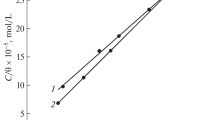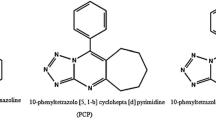Abstract
We have theoretically studied mechanical and electric phenomena at the interface St3 steel–electrolyte solution containing H2SO4 (0.1%) and also heterocyclic compounds with a concentration of (0.001–0.01) M. These compounds were N pyridine oxide, 2-aminopyridine, 4-picoline, pyridine, 2-butylpyridine, 3-picoline, 2.6-lutidine, pyridine zaldehyde, 3.5-lutidine, 3.5-dibromopyridine, quinoline, and lepidine. We took into account interfacial energy, interfacial tension, and also the variation of electric potential ΔΨ in the interphase region at ΔT = T a − T b. We have established the relation between the interfacial energy and the corrosion coefficient for St3 steel in organic (corrosive) solutions. The results of computations were compared with analogous numerical data for corrosive solutions obtained by the Born–Mayer potential method, and these results agree well with each other. Deviations of the values of γ m and also of their variations do not exceed 5%.
Similar content being viewed by others
REFERENCES
V. M. Yuzevych, “Criteria of the strength of a solid with regard for the scale effect and the influence of environment,” Fiz.-Khim. Mekh. Mater., 35, No. 2, 80–85 (1999).
C. W. Price and J. P. Hirth, “Surface energy and surface stress tensor in an atomistic model,” Surf. Sci., 57, No. 2, 509–522 (1976).
N. H. Macmillan, “The ideal strength of solids,” in: R. Latanision and J. R. Pickens (editors), Atomistics of Fracture, Plenum, New York (1983), pp. 95–164.
M. Mostoller and M. Rasolt, “Pair potentials at simple metal surfaces,” Phys. Lett., 88A, No. 2, 93–96 (1982).
N. Eustathopoulus and J.-C. Joud, “Interfacial tension and adsorption of metallic systems,” in: Curr. Top. Mater. Sci., Vol. 4 (1980), pp. 281–360.
Tables of Physical Quantities: Handbook [in Russian], Atomizdat, Moscow (1976).
M. Green (editor), Solid State Surface Science, Vol. 1, Marcel Dekker, New York (1969).
V. P. Kuprin, M. V. Ivanova, and A. G. Teplitskaya, “Some specific features of the adsorption and inhibitor properties of heterocycles on iron and steel,” in: Proc. of the 4th Int. Conf.-Exhibition “Problems of Corrosion and Rust Protection of Materials” (“Corrosion-98,” Lviv, June 9-11) [in Ukrainian], PMI, Lviv (1998), pp. 332–334.
M. B. Partenskii, “A self-consistent electronic theory of metal surface,” Usp. Fiz. Nauk, 128, No. 1, 69–106 (1979).
D. C. Montgomery, Design and Analysis of Experiments [Russian translation], Mir, Moscow (1981).
Author information
Authors and Affiliations
Rights and permissions
About this article
Cite this article
Soprunyuk, P.M., Yuzevych, V.M., Luhovyi, P.V. et al. Relationship between Interfacial Energy and Corrosion of Steel in Heterocyclic Compounds. Materials Science 38, 88–94 (2002). https://doi.org/10.1023/A:1020128916520
Issue Date:
DOI: https://doi.org/10.1023/A:1020128916520




